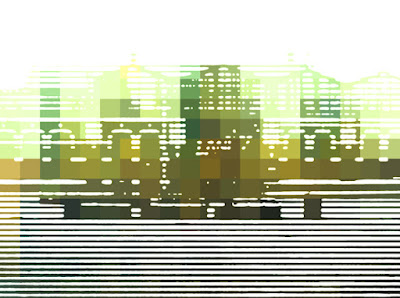"...the specific pleasure of travelling is not that it enables one to stop when tired or stay somewhere along the way; it is that it can make the difference between departure and arrival not as unnoticeable as possible, but as profound as possible; it is that one can experience that difference in its entirety, as intact as it was in our mind when imagination transported us immediately from where we were living to where we yearned to be, in a leap which seemed miraculous less because it made us cover such a distance than because it linked two distinct personalities of place, taking us from one name to another name, a leap which epitomized (more acutely than by a run in a motor-car, which allows you to get out where you like and thereby all but abolishes arrival) by that mysterious performance that used to be enacted in those special places, railway stations, which, though they are almost separate from the city, contain the essence of its individuality, as they bear its name on a signboard." [1.]
 |
| Claude Monet, 'The Gare Saint-Lazare (Interior View of the Gare Saint-Lazare, The Auteuil Line)', Oil on Canvas, 1877, Musee d'Orsay, Paris |
"Sad to say, those wonderful places, railway stations, our starting-point for a distant destination, are also tragic places, for though they are the setting for the miracle which will turn a land hitherto non-existent except in the mind of into one we are going to live in, for that very reason, as soon as we venture outside the waiting-room, we must abandon all hope of returning to the familiar bedroom which we left only a moment before. We have to give up all prospect of sleeping at home tonight, as soon as we have decided to venture into the reeking cavern which is the necessary anteroom to mystery, one of those huge glass-roofed machine-shops, such as the Gare Saint-Lazare, which was where I had to seek out the train for Balbec and which, above the great chasm slitting the city, had spread out one of those vast bleak skies, dense with portents of pent-up tragedy, resembling certain skies of Mantegna's and Veronese's fraught with their quasi-Parisian modernity, an apt backdrop to the most awesome or hideous of acts, such as the Crucifixion or a departure by train." [2.]
 |
| Walter Richard Sickert, 'St. Mark's, Venice (Pax Tibi Marce Evangelista Meus)', Oil on Canvas, 1896 (Tate Gallery Collection) |
[1. & 2.]: Marcel Proust, 'In Search of Lost Time, Volume 2, In The Shadow of Young Girls in Flower', Part II: 'Place-names: the Place' (Trans. James Grieve), London, Penguin Books, 2002/1919.









No comments:
Post a Comment